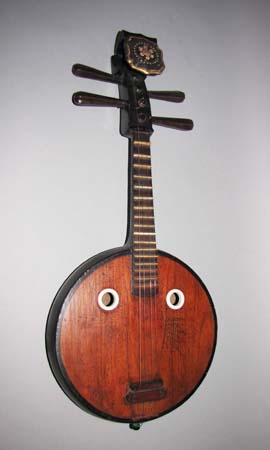
Owner: HWMC
Catalog#: AS-CHLT-58-14
Lutes
Chinese 'Ruan'
China
Chinese
Wood, ivory, bone, metal, steel strings, gilt gold
Late 19th century
Length: 27 in, Soundbox diameter: 12 in, Depth: 3 in
Chordophones – Lutes
The ruan is a plucked long-necked lute of the Han Chinese, sometimes referred to as the Chinese “mandolin”. This 19th century ruan consists of a circular body with hardwood used for the neck and rim, while the top sound board and back are made of a softer, lighter wood. The neck is joined to the body with a fingerboard that extends slightly on to the soundboard with 17 raised ivory frets. The peghead is sickle-shaped and ends in a curl to the front, with a special Chinese decoration in gilt gold paint. There are four pegs for the four steel strings that run over the bamboo bridge on the sound board to the string holder at the bottom. The four lateral wooden pegs are part of a special invisible tuning mechanism that tightens and loosens the strings on the front of the closed peghead.
Today, the ruan is constructed in five sizes: gaoyin ruan (soprano), xiaoruan (alto), zhong ruan (tenor), daruan (bass) and diyinruan (contrabass). The ruan is now most commonly used in Chinese opera and the Chinese orchestra. In Chinese orchestras, only the zhongruan and daruan are used, to fill in the tenor and bass section of the plucked string section. Occasionally the gaoyinruan is used to substitute the high-pitched liuqin.
With a history of over 2000 years, the ruan has gone by several names: the qin pipa (pipa of the Qin dynasty), ruanxian and yueqin in the music treatise Yueshu (c. 1100 C.E., meaning “moon-shaped lute”, though now yueqin refers to a separate relative of the ruan which has no sound holes).
